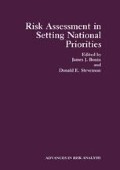Abstract
The Hazardous Air Pollution Prioritization System (HAPPS) is used to rank toxic air pollutants as the first step in the Environmental Protection Agency’s regulatory assessment under the Clean Air Act. The purpose of this exercise is to assist in setting the priorities for assessment and focus resources on the chemicals with the greatest potential for public health risks. The HAPPS has evolved over several years based on a system developed at the Oak Ridge National Laboratory and later modified at Argonne National Laboratory. The current system can be run on a personal computer and focuses on air pollutants rather than multimedia exposures. It is designed to rank large numbers of chemicals based on limited, readily available information. Ranking is based on health information and surrogates for population exposure. More specifically, substances are scored on eight factors: oncogenicity, mutagenicity, reproductive and developmental toxicity, acute lethality, other toxic effects, the potential for airborne release (production volume and volatility), bioaccumulation and existing standards. The system possesses a somewhat flexible ranking scheme that can be easily modified to reflect different issues such as concern for acute exposures and the impact of combustion sources on exposure.
Access this chapter
Tax calculation will be finalised at checkout
Purchases are for personal use only
Preview
Unable to display preview. Download preview PDF.
References
R. H. Ross and J. Welch, Proceedings of the EPA Workshop on the Environmental Scoring of Chemicals, ORNL/EIS–158, EPA–560/11–80–010, Oak Ridge National Laboratory, Oak Ridge, Tennessee (1980).
A. E. Smith and D. J. Fingleton, Hazardous Air Pollutant Prioritization System, U.S. Environmental Protection Agency, Research Triangle Park, North Carolina (EPA 450/5–82–008) (1982).
Radian Corporation, Modified Hazardous Air Pollutant Prioritization System,U.S. Environmental Protection Agency, Research Triangle Park, North Carolina (EPA Contract No. 68–02–4330) (1987).
R. J. Lewis and R. L. Tatken, Eds., Registry of Toxic Effects of Chemical Substances, Vols. I and II, U.S. Department of Health and Human Services, National Institute for Occupational Safety and Health, Cincinnati, Ohio (1979).
Stanford Research Institute, Chemical Economics Handbook, Stanford Research Institute, Menlo Park, California (1982).
National Toxicology Program, Chemicals on Standard Protocol, Carcinogenesis Testing Program, National Toxicology Program, Bethesda, Maryland (1987).
National Toxicology Program, Annual Plan, National Toxicology Program, Bethesda, Maryland (1987).
Author information
Authors and Affiliations
Editor information
Editors and Affiliations
Rights and permissions
Copyright information
© 1989 Plenum Press, New York
About this chapter
Cite this chapter
Cote, I.L., Pelland, A.S., Coerr, S.P. (1989). The Hazardous Air Pollutant Prioritization System. In: Bonin, J.J., Stevenson, D.E. (eds) Risk Assessment in Setting National Priorities. Advances in Risk Analysis, vol 7. Springer, Boston, MA. https://doi.org/10.1007/978-1-4684-5682-0_14
Download citation
DOI: https://doi.org/10.1007/978-1-4684-5682-0_14
Publisher Name: Springer, Boston, MA
Print ISBN: 978-1-4684-5684-4
Online ISBN: 978-1-4684-5682-0
eBook Packages: Springer Book Archive

